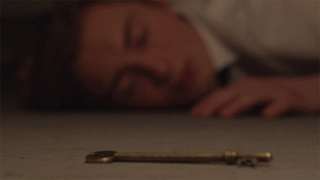This thriller opening sequence called Blitz is about the disappearance
of a little girl in a WWII air raid bunker.
Setting
- The setting is established immediately through the audio and room of the bunker.
- There are realistic Wartime props, such as the propaganda posters and rationing. The slow camera pans really highlight the amount of meticulous care that the director took in terms of props
- The props such as the clock and documents suggest that the characters are frequently down there, and also give the audience a sense of time that was taking place.
- The slow camera pans at the beginning – we see the pipes above the bunker. This creates a feeling of emptiness and scale but also entrapment as we see how far underground it is. We begin to ask how big is it down there?
- We hear Churchill’s speech with distant bomb sounds, of which we immediately recognise that to be WWII.
- There is a lack of speech: No one talks in this clip. The only diegetic sounds are the speech and the bombs. This makes the audience feel uncomfortable, as we do not know who the characters are and what happened to them. We want to keep watching to find out what happened to these characters.
- The music used is slow and creepy. This is really effective in building tension as it makes the audience uncomfortable.
- Some of the camera shots used when the explorer are inspecting documents and papers, go on for too long and lose the interest of the audience. I would cut down those shots and maybe add a variety of inspecting shots instead of one long shot.
- The font used is curvy like a typewriter. However I think the director could have used a sharper and more old-fashioned font, which would resemble more to a typewriter. The font used looks new and looks very ‘comicy’ and upbeat which contradicts the mood and genre of the film.
- The title card is ‘typed like a typewriter’ which I think is really effective however I think should stay on the screen for longer to drag out the suspense and fear that the audience are still feeling after the jump.
- The use of rapid translucent frames foreshadows the upcoming events in the film
Character
- We originally feel sorry and scared for the girl, as she is in the middle of the blitz and is innocent. Because she is a child we have immediate protective instincts and therefore we care for and trust her.
- But presently we then begin to become afraid for the explorer, as we know something bad has happened in that bunker 60 years ago. We are afraid of the girl now.
- We see a photograph on the desk of a man in army uniform, in what we assume is her father. Perhaps this is the shadow man?
- The shadow is really effective as this emits power and fear because we don’t know what he looks like. His identity is hidden from the audience. That feeling of the unknown is what makes the audience fear him.
- The camera shots are really effective such as the close up of the clown toy. It’s old and abandoned, just like the little girl in the present day. The audience feels uncomfortable and tense from the toy.
- The director uses the same technique of the shadow of the man and the shadow of the girl. This is really effective as we wonder if the same thing will happen to the explorer as it did to the girl 60 years prior. The shadows are also the same height, which suggests that the girl has grown up, and leaves us questioning what exactly happened to her.
- As we see the same use of the shadow, (which we subconsciously link to the shadow man)
- The climax of the tension is the explorer turning around to see the girl standing above him and wearing a gas mask. The music here creates a horrible clanging sound to make the audience jump.
- The rest of the film may have flashbacks between what happened to the girl and what will happen to the explorer. Perhaps the explorer will be trying to escape the bunker but finding out more about the mystery on the way. We know that we will find out what will happen to the girl because of the massive time jump used in the opening sequence.
Tags:
a1









1 comments
I really like this post too, well done.
ReplyDelete